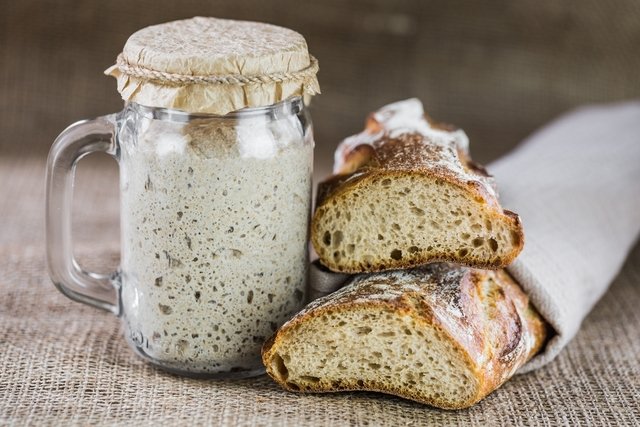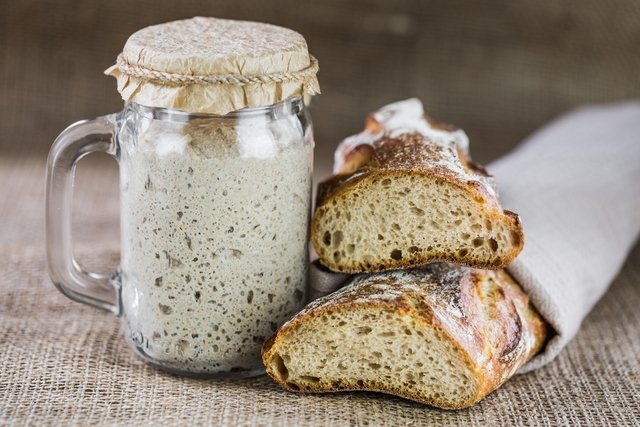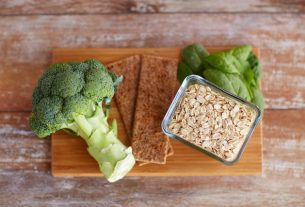Natural yeast is a yeast made with the microorganisms present in the flour. This means that it is made by mixing just wheat flour with water and waiting a few days for the natural yeast dough to form, usually ready to use within 10 days.
This natural fermentation, carried out without adding any artificial, biological or chemical yeast, is also called “mother dough” or sourdough starter, and can be used to make bread, cookies, pizza dough, or pies. Breads made this way have a slight sour flavor, reminiscent of more rustic breads.
One of the main health advantages of this type of fermentation is that the dough is better digested, as the digestion process is already being carried out by microorganisms during production, resulting in less sensitivity to gluten or gas formation in more sensitive people. .

Main health benefits
The main benefits of consuming bread and other products prepared with natural yeast are:
- Facilitate the digestive processas the microorganisms present in the food help to degrade proteins, including gluten, present in wheat and rye during the fermentation process, therefore being beneficial for people with gluten sensitivity;
- Promote intestinal healththis is because some studies indicate that these products contain prebiotics and probiotics that promote intestinal functioning and absorption of vitamins;
- Provide more nutrients to the body, as it reduces the absorption of phytates, which are substances that interfere with the absorption of some minerals. Furthermore, it is also capable of increasing the concentration of folate and vitamin E;
- Greater amount of antioxidantswhich are released by bacteria during the fermentation process, protecting cells from cellular damage caused by free radicals;
- Possibility to control blood sugar levelsas it is believed to be due to the fact that the fermentation process modifies the structure of carbohydrates, reducing their glycemic level and maintaining blood glucose levels.
Furthermore, fermentation also helps to improve the flavor and texture of whole grain bread, thus promoting the consumption of fiber and nutrients.
How to make natural yeast at home
Natural yeast is prepared with some cereal flour and water. When these ingredients are mixed at room temperature, they trap microorganisms in the air and, together with yeast, begin the fermentation process.
Starting ingredients
- 50 g of wheat flour;
- 50 mL of water.
Preparation mode
- Mix the wheat flour and water, cover and let it rest at room temperature for 24 hours;
- Add 50 g of flour and 50 mL of water again and let it rest for another 24 hours;
- Add another 50 g of flour and 50 mL of water and let it rest for another 24 hours;
- On the third day (sometimes the second or fourth) the dough will show fermentation bubbles. When this happens, the “discarding” process must begin, which consists of removing 100 g of the dough and “feeding” it with 100 g of flour and 100 mL of water, leaving it to rest for another 12 hours. The fermented dough that was removed can be thrown in the trash or buried to compost the earth, for example;
- Repeat the “discarding” process every 12 hours, for another 3 or 4 days, always removing 100 g of dough and feeding it again with 100 g of flour and 100 mL of water;
- After this period, you can remove a “bait” from the dough (approximately 50-100 g) and store it in the refrigerator. The remaining dough can be used to prepare bread or any other recipe.
During the fermentation process, it is natural for the dough to have a characteristic odor, which can range from a sweet smell to a vinegar-like smell.
See in more detail in the following video how to make natural yeast:
How to preserve and use the “bait”
The natural yeast “bait” can be kept at room temperature whenever you want to produce bread every day. However, it is important to remember that it must be “fed” every day, with twice as much flour and water.
However, when cooking at home, in most cases there is no need to produce bread every day and, therefore, the “bait” can be stored in the refrigerator for up to 2 weeks. In these cases, to use the “bait” you must remove it from the refrigerator and let it rest at room temperature for about 8 hours.
If you want to continue feeding the “bait” and obtaining more natural yeast, you must weigh the amount you have and feed it with twice that amount of flour and water. For example, if it is found that the “bait” weighs 50 g, 100 g of flour and 100 mL of water must be added. Then just let it rest for another 12 hours and then you can remove part of it to make a new recipe and store a new “bait” weighing 100 to 50 g in the fridge, to maintain the fermentation process.
What is the ideal room temperature?
The ideal temperature to keep microorganisms active is 25º C.
What to do if you don’t use the “bait”?
If the bait is not used in recipes or at least once a week, it is important that the “feeding” continues to occur, otherwise the microorganisms may die, and then it is necessary to start the 10-day process again until get ready. But well-cared for yeast dough stays alive for many years.
Natural yeast bread recipe
Ingredients (for 2 loaves)
- 800 grams of wheat flour;
- 460 mL of warm water;
- 10 g of salt;
- 320 grams of natural yeast.
Preparation mode
Place the flour in a container and add warm water, salt and natural yeast. Mix all the ingredients until incorporated and then place the dough on a flat surface. At first, you may notice the dough is a bit watery, however, as it is kneaded, it takes on shape and consistency.
Start kneading the dough manually until it starts to become sticky. It is recommended not to add any more flour or water, and continue the process normally: stretching the dough and folding it over itself, thus allowing the air to be captured.
To know if the dough is ready, simply do the membrane test, in which you must hold a piece of dough and stretch it between your fingers. If the dough is ready, it will not break. Then, place the dough in a container and let it rest.
It is important to remember that when using sourdough (natural yeast), the process is more natural and, therefore, happens more slowly. Therefore, the bread dough must rest for longer, and it is recommended to leave it for around 3 hours. After this period, you can remove the dough from the container and divide it into two parts to prepare 2 loaves. If the dough is a little sticky, it can be sprinkled with a little flour until the desired consistency is achieved.
Regardless of the shape, you must start with a round base and, to do this, you must rotate the dough, grab the edges and stretch them towards the center. Turn the dough over again and make circular movements.
Then, in another container, place a clean cloth and sprinkle a little flour on the cloth. Then, add the dough, sprinkle a little more flour and cover, leaving to rest for another 3 hours and 30 minutes. Then remove from the container and place on a suitable tray and make small cuts on the surface of the dough.
It is recommended to preheat the oven to 230ºC and, when heated, place the bread to bake for around 25 minutes. Then, remove the bread from the tray and bake for another 25 minutes.

Sign up for our newsletter and stay up to date with exclusive news
that can transform your routine!
Warning: Undefined array key "title" in /home/storelat/public_html/wp-content/plugins/link-whisper-premium/templates/frontend/related-posts.php on line 12
Warning: Undefined array key "title_tag" in /home/storelat/public_html/wp-content/plugins/link-whisper-premium/templates/frontend/related-posts.php on line 13




